Investigation of Fatigue Load Spectrum Enhancement via Equivalent Plastic Zone
Abstract
1. Introduction
2. Materials
2.1. Material Property
2.2. Specimen
2.3. Experimental Setup
2.4. Model Development
2.4.1. Equivalent Initial Flaw Size
2.4.2. Equivalent Plastic Zone
2.4.3. Fatigue Life Prediction Model Under Variable Amplitude Loading
3. Results and Discussion
3.1. Model Prediction
3.1.1. Model Calibration
3.1.2. Calculation of EIFS
3.1.3. Estimation of Crack Closure
3.1.4. Fatigue Life Prediction
3.2. Model Validation
4. Conclusions
Author Contributions
Funding
Informed Consent Statement
Data Availability Statement
Conflicts of Interest
Abbreviations
| CA | Constant amplitude |
| EIFS | Equivalent initial flaw size |
| EPZ | Equivalent plastic zone |
| LEF | Load enhancement factor |
| LEFM | Linear elastic fracture mechanics |
| SIF | Stress intensity factor |
| VCA | Virtual crack annealing |
| VA | Variable amplitude |
Nomenclature
| Symbol | Illustration |
| a | Crack length |
| a0 | Initial crack length |
| aEIFS | Equivalent initial flaw size |
| Ai(i = 1,2,3) | Crack closure coefficients |
| C,m | Material constants |
| da | Crack increment |
| da/dN | Crack growth rate |
| dm | Monotonic crack tip plasticity zone size |
| dr | Reverse crack tip plasticity zone size |
| Deq | Equivalent crack tip plasticity zone size |
| Dm,eq | Monotonic equivalent crack tip plasticity zone size |
| Dr,eq | Reverse equivalent crack tip plasticity zone size |
| f | Crack closure parameter |
| Kt | Theoretical stress concentration factor |
| Kmax | Maximum stress intensity factor |
| Kop | Crack opening stress intensity factor |
| ΔK | Stress intensity factor |
| ΔKeff | Effective stress intensity factor |
| ΔKth | Threshold stress intensity factor |
| ΔKth,eff | Effective threshold stress intensity factor |
| R | Stress ratio |
| T | Specimen thickness |
| U | Crack closure ratio |
| Y | Geometric correction factor |
| σmax | Maximum stress |
| σmin | Minimum stress |
| σmin,eq | Equivalent minimum stress |
| σop | Crack closure stress |
| σy | Yield strength |
| Δσfl | Fatigue limit |
References
- He, X.; Li, T.; Li, Y.; Dong, Y.; Wang, T. Developing an accelerated flight load spectrum based on the nz-N curves of a fleet. Int. J. Fatigue 2018, 117, 246–256. [Google Scholar] [CrossRef]
- Heuler, P.; Seeger, T. A criterion for omission of variable amplitude loading histories. Int. J. Fatigue 1986, 8, 225–230. [Google Scholar] [CrossRef]
- Hailing, T.; Rui, B.; Jianyu, Z.; Xiaoling, Z.; Binjun, F. Influence of Low Load Truncation Level on Crack Growth for Al 2324-T39 and Al 7050-T7451. Chin. J. Aeronaut. 2009, 22, 401–406. [Google Scholar] [CrossRef][Green Version]
- Xiong, J.J.; Shenoi, R.A. A load history generation approach for full-scale accelerated fatigue tests. Eng. Fract. Mech. 2008, 75, 3226–3243. [Google Scholar] [CrossRef]
- Lameris, J. The Use of Load Enhancement Factors in the Certification of Composite Aircraft Structures; National Aerospace Laboratory NLR: Delft, The Netherlands, 1990; p. 58. [Google Scholar]
- Brandecker, B.; Hilgert, R. A320 full scale structural testing for fatigue and damage tolerance certification of metallic and composite structure. In Proceedings of the Congress of the International Council of the Aeronautical Sciences, Jerusalem, Israel, 28 August–2 September 1988; Volume 16, pp. 1244–1256. [Google Scholar]
- Tomblin, J.; Seneviratne, W. Determining the Fatigue Life of Composite Aircraft Structures Using Life and Load-Enhancement Factors; Air Traffic Organization: Washington DC, USA, 2011. [Google Scholar]
- Dong, D.; Li, Y.; Chen, X. Research on the relationship between load enhancement factor and fatigue life. J. Mech. Strength 2013, 35, 488–492. [Google Scholar] [CrossRef]
- Dang, K.; Chen, L.; Zhang, W. Load spectrum enhancement method with ground-air-ground invariance of aircraft metal structure. Eng. Test 2022, 62, 27–30. [Google Scholar] [CrossRef]
- Zhang, W.; Dong, D.; Chen, L.; Li, S. Effect on single crack growth lifetime with random fatigue load spectra enhancement. Sci. Technol. Eng. 2018, 18, 326–331. [Google Scholar] [CrossRef]
- Zhang, K.; Yan, W.; Chen, L.; Dong, D. Effect of structural load enhancement factor on fatigue crack growth life. J. Mech. Strength 2014, 36, 280–284. [Google Scholar] [CrossRef]
- Zhang, H.; Niu, Z.; Dong, D.; Chen, L. Research on load enhancement method for fatigue crack growth test. Eng. Mech. 2015, 32, 236–242. [Google Scholar] [CrossRef]
- Suresh, S.; Ritchie, R.O. Propagation of short fatigue cracks. Int. Met. Rev. 1984, 29, 445–475. [Google Scholar] [CrossRef]
- Miller, K.J. The behaviour of short fatigue cracks and their initiation part ii-a general summary. Fatigue Fract. Eng. M 1987, 10, 93–113. [Google Scholar] [CrossRef]
- Sangid, M.D. The physics of fatigue crack propagation. Int. J. Fatigue 2025, 197, 108928. [Google Scholar] [CrossRef]
- Newman, J.C.; Phillips, E.P.; Swain, M.H. Fatigue-life prediction methodology using small-crack theory. Int. J. Fatigue 1999, 21, 109–119. [Google Scholar] [CrossRef]
- McEvily, A.J. An analysis of the growth of small fatigue cracks. Mater. Sci. Eng. A 1991, 143, 127–133. [Google Scholar] [CrossRef]
- Ye, S.; Zhang, C.; Zhang, P.; Zhang, X.; Tu, S.; Wang, R. Fatigue life prediction of nickel-based GH4169 alloy on the basis of a multi-scale crack propagation approach. Eng. Fract. Mech. 2018, 199, 29–40. [Google Scholar] [CrossRef]
- Santus, C.; Taylor, D. Physically short crack propagation in metals during high cycle fatigue. Int. J. Fatigue 2009, 31, 1356–1365. [Google Scholar] [CrossRef]
- Hobson, P.D.; Brown, M.; Rios, E.R. Two Phases of Short Crack Growth in a Medium Carbon Steel. In The Behaviour of Short Fatigue Cracks; EGF Pub.1; Miller, K.J., Rios, E.R., Eds.; Mechanical Engineering Publications: London, UK, 1986. [Google Scholar]
- Hutař, P.; Poduška, J.; Šmíd, M.; Kuběna, I.; Chlupová, A.; Náhlík, L.; Polák, J.; Kruml, T. Short fatigue crack behaviour under low cycle fatigue regime. Int. J. Fatigue 2017, 103, 207–215. [Google Scholar] [CrossRef]
- Shyam, A.; Allison, J.E.; Jones, J.W. A small fatigue crack growth relationship and its application to cast aluminum. Acta Mater. 2005, 53, 1499–1509. [Google Scholar] [CrossRef]
- Molent, L.; Sun, Q.; Green, A.J. Characterisation of equivalent initial flaw sizes in 7050 aluminium alloy. Fatigue Fract. Eng. Mater. 2006, 29, 916–937. [Google Scholar] [CrossRef]
- Liu, Y.; Mahadevan, S. Probabilistic fatigue life prediction using an equivalent initial flaw size distribution. Int. J. Fatigue 2009, 31, 476–487. [Google Scholar] [CrossRef]
- Xiang, Y.; Lu, Z.; Liu, Y. Crack growth-based fatigue life prediction using an equivalent initial flaw model. Part I: Uniaxial loading. Int. J. Fatigue 2010, 32, 341–349. [Google Scholar] [CrossRef]
- Wang, Q.; Zhang, W.; Jiang, S. Fatigue life prediction based on crack closure and equivalent initial flaw size. Materials 2015, 8, 7145–7160. [Google Scholar] [CrossRef]
- Zhang, W.; Wang, Q.; Li, X.; He, J. A simple fatigue life prediction algorithm using the modified NASGRO equation. Math. Probl. Eng. 2016, 2016, 4298507. [Google Scholar] [CrossRef]
- Kitagawa, H.; Takahashi, S. Fracture mechanical approach to very small fatigue crack growth and to the threshold condition. Trans. Jpn. Soc. Mech. Eng. A 1979, 45, 1289–1303. [Google Scholar] [CrossRef]
- Schijve, J. The application of small overloads for fractography of small fatigue cracks initiated under constant-amplitude loading. Int. J. Fatigue 2015, 70, 63–72. [Google Scholar] [CrossRef]
- Schijve, J. The significance of fractography for investigations of fatigue crack growth under variable-amplitude loading. Fatigue Fract. Eng. Mater. Struct. 1999, 22, 87–99. [Google Scholar] [CrossRef]
- Wheeler, O.E. Spectrum loading and crack growth. J. Basic Eng. 1972, 94, 181–186. [Google Scholar] [CrossRef]
- Willenborg, J.; Engle, R.; Wood, H. A Crack Growth Retardation Model Using an Effective Stress Concept; Wright-Patterson Air Force Base: Dayton, OH, USA, 1971. [Google Scholar]
- Neto, D.M.; Borges, M.F.; Antunes, F.V.; Jesus, J. Mechanisms of fatigue crack growth in Ti-6Al-4V alloy subjected to single overloads. Theor. Appl. Fract. Mech. 2021, 114, 103024. [Google Scholar] [CrossRef]
- Ward-Close, C.M.; Blom, A.F.; Ritchie, R.O. Mechanisms associated with transient fatigue crack growth under variable-amplitude loading: An experimental and numerical study. Eng. Fract. Mech. 1989, 32, 613–638. [Google Scholar] [CrossRef]
- Li, Y.; Ke, L.; Li, C.; Feng, P.; Feng, Z.; Qiu, M. Retardation mechanisms and modeling of fatigue crack growth of a high-strength steel after single overload. Int. J. Fatigue 2024, 183, 108267. [Google Scholar] [CrossRef]
- Zhang, W.; Liu, Y. In Situ SEM testing for crack closure investigation and virtual crack annealing model development. Int. J. Fatigue 2012, 43, 188–196. [Google Scholar] [CrossRef]
- Jiang, S.; Zhang, W.; He, J.; Wang, Z. Comparative study between crack closure model and willenborg model for fatigue prediction under overload effects. Chin. J. Aeronaut. 2016, 29, 1618–1625. [Google Scholar] [CrossRef]
- Zhang, W.; Jiang, S.; Li, X.; Wang, Z. An approach to structural reliability evaluation under fatigue degradation and shocks. Mech. Syst. Signal Process. 2018, 113, 65–76. [Google Scholar] [CrossRef]
- ASTM E647-08; Standard Test Method for Measurement of Fatigue Crack Growth Rates. ASTM International: West Conshohocken, PA, USA, 2008.
- Yamada, Y.; Ziegler, B.; Newman, J.C. Application of a strip-yield model to predict crack growth under variable-amplitude and spectrum loading—Part 1: Compact specimens. Eng. Fract. Mech. 2011, 78, 2597–2608. [Google Scholar] [CrossRef]
- Elber, W. The significance of fatigue crack closure. In Damage Tolerance in Aircraft Structures; Rosenfeld, M., Ed.; ASTM International: West Conshohocken, PA, USA, 1971; Volume STP486-EB, pp. 230–242. ISBN 978-0-8031-0031-2. [Google Scholar]
- Newman, J.C. A crack opening stress equation for fatigue crack growth. Int. J. Fract. 1984, 24, R131–R135. [Google Scholar] [CrossRef]
- Führing, H. Approximation functions for K-factors of cracks in notches. Int. J. Fract. 1973, 9, 328–331. [Google Scholar] [CrossRef]
- Yao, W. Fatigue Life Estimation of Structures, 1st ed.; Science Press: Beijing, China, 2019; ISBN 978-7-03-058465-6. [Google Scholar]
- Schijve, J. Fatigue of Structures and Materials, 2nd ed.; Springer: Dordrecht, The Netherlands, 2009; ISBN 978-1-4020-6807-2. [Google Scholar]



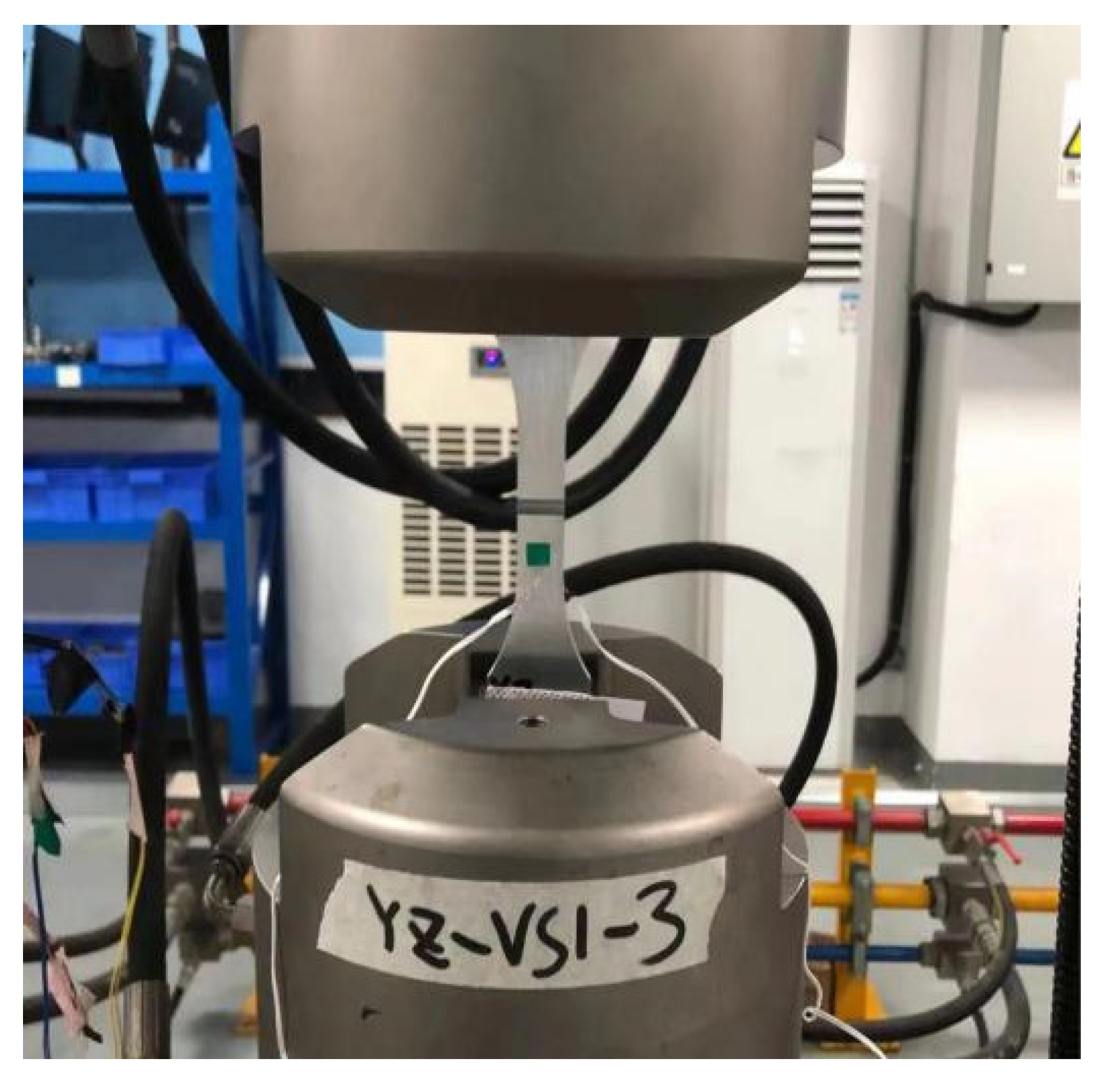


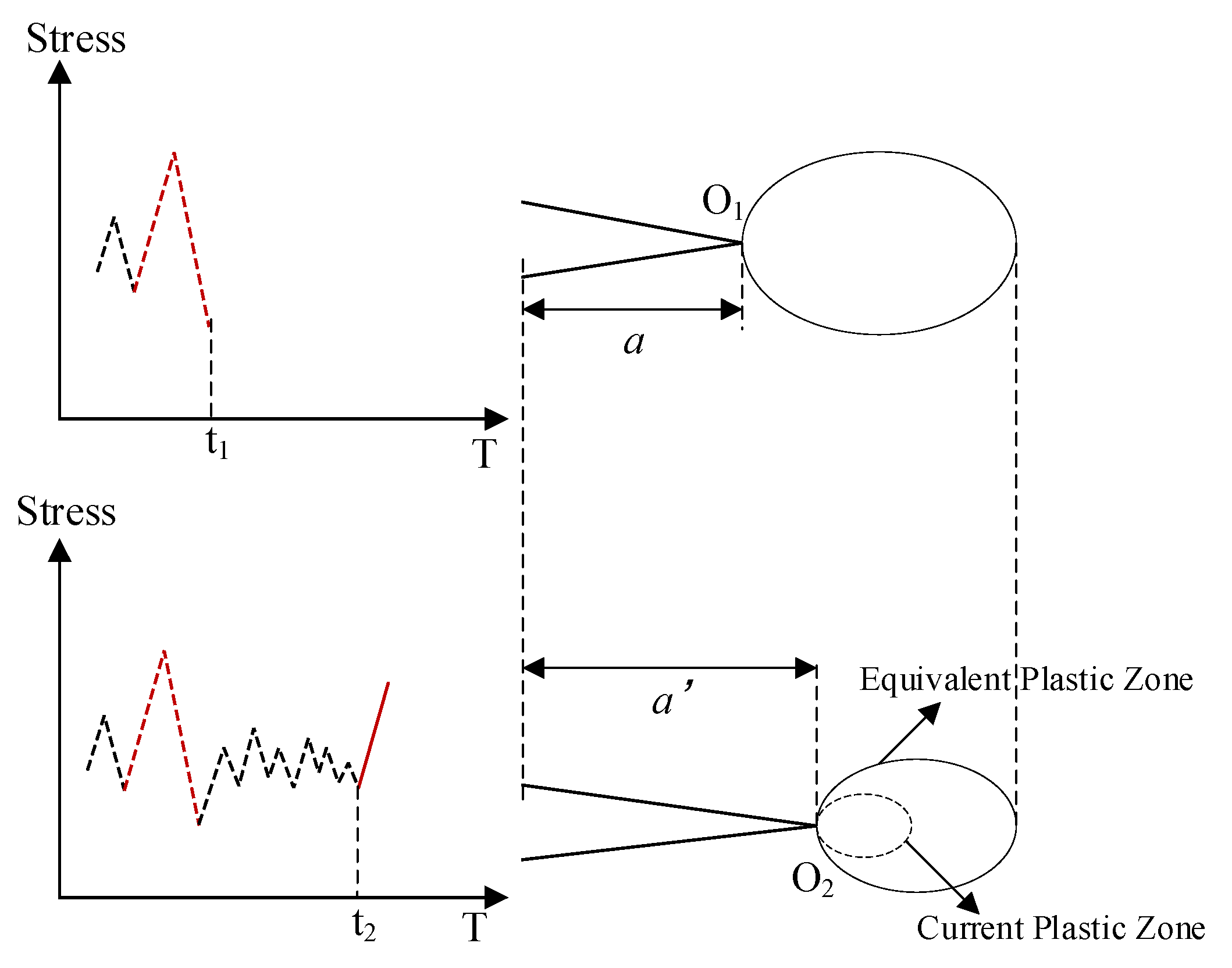
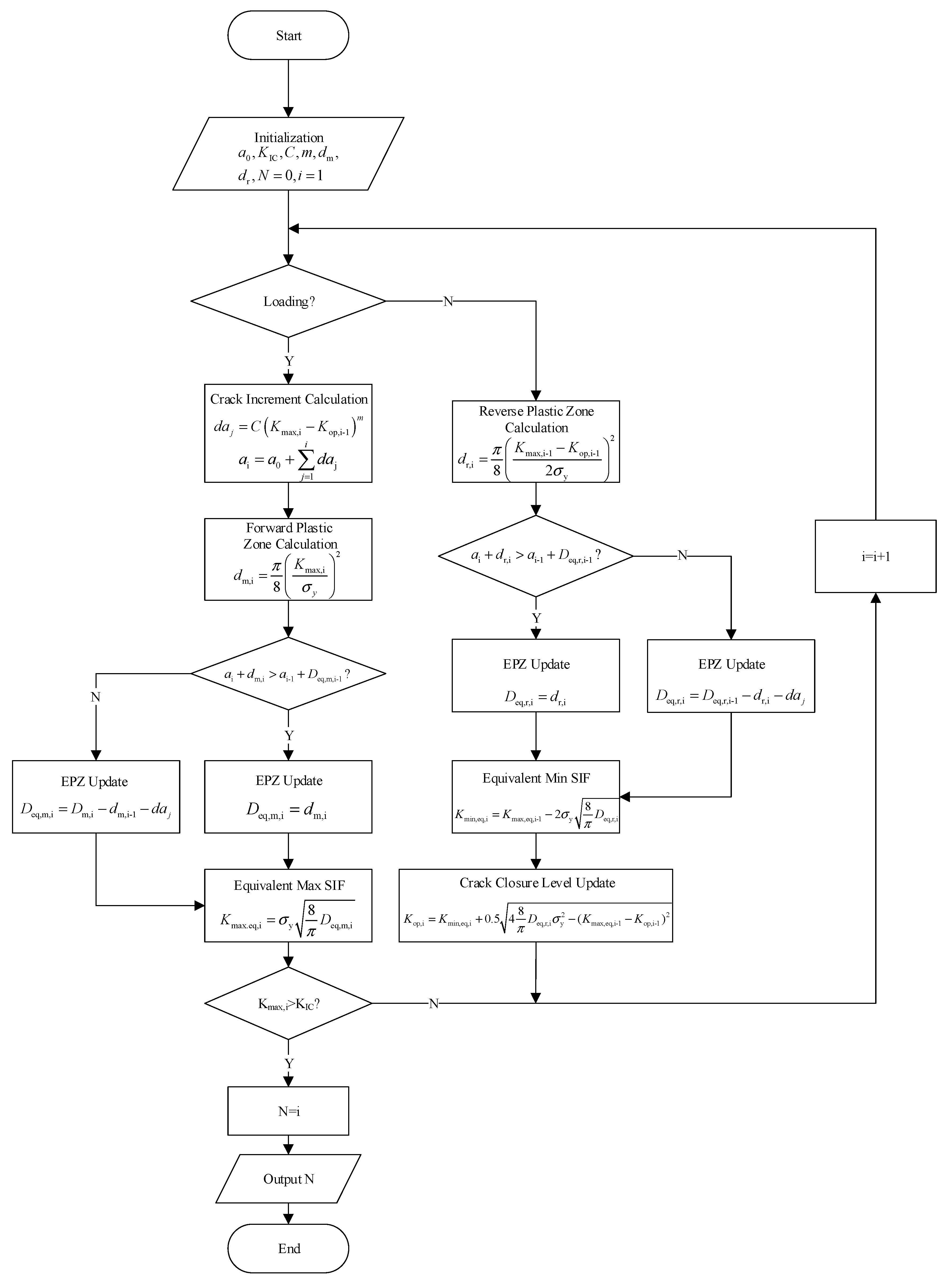
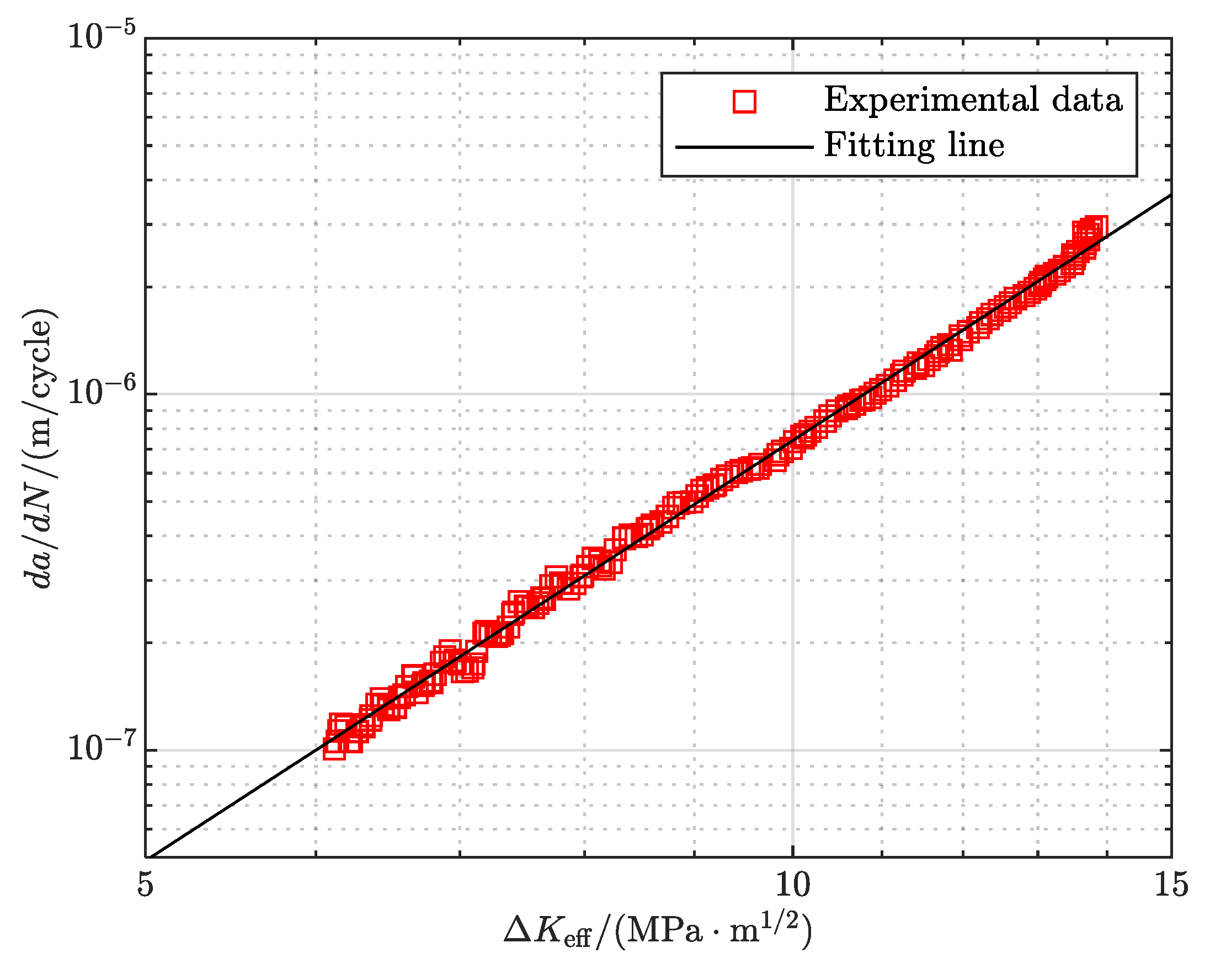

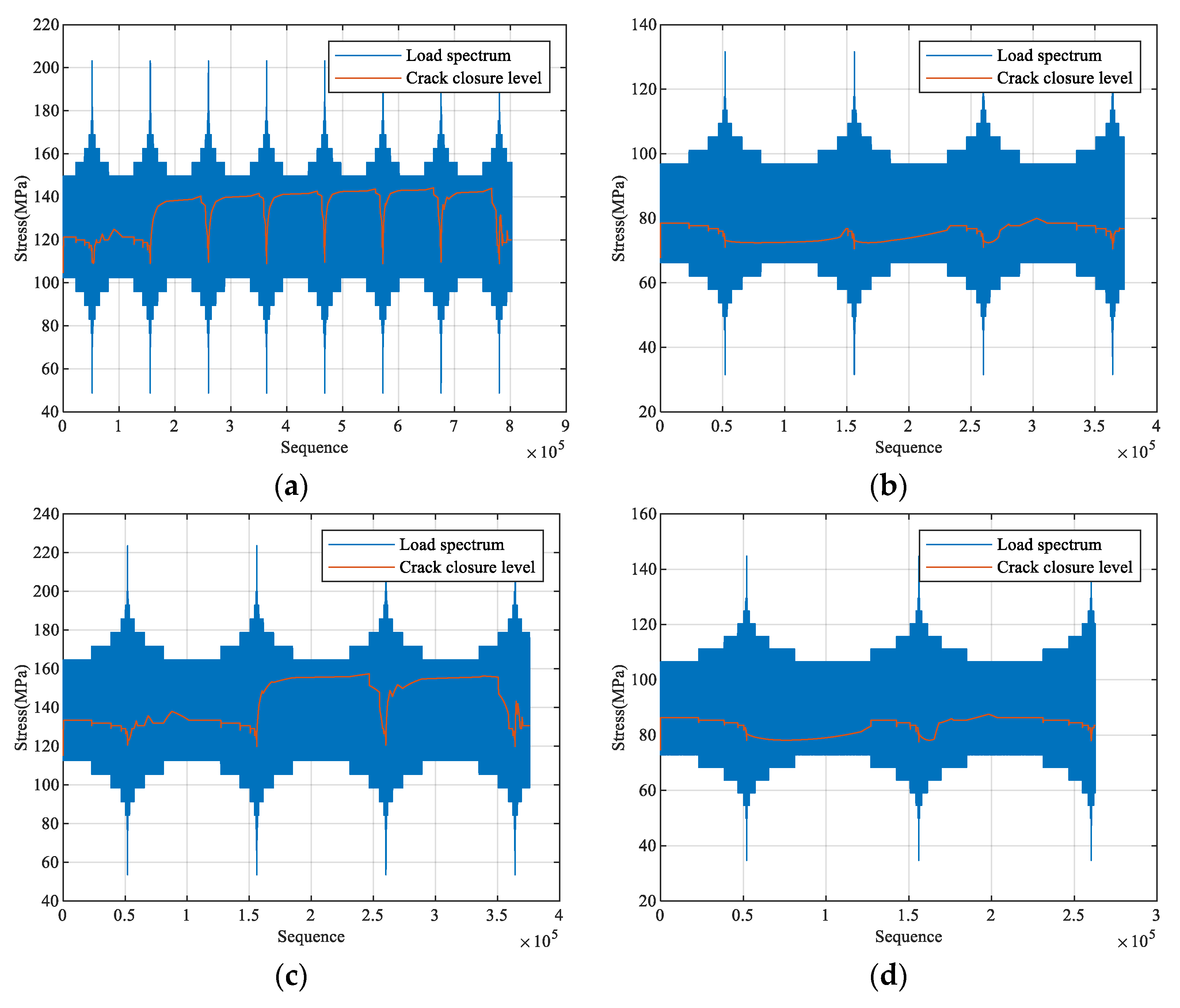

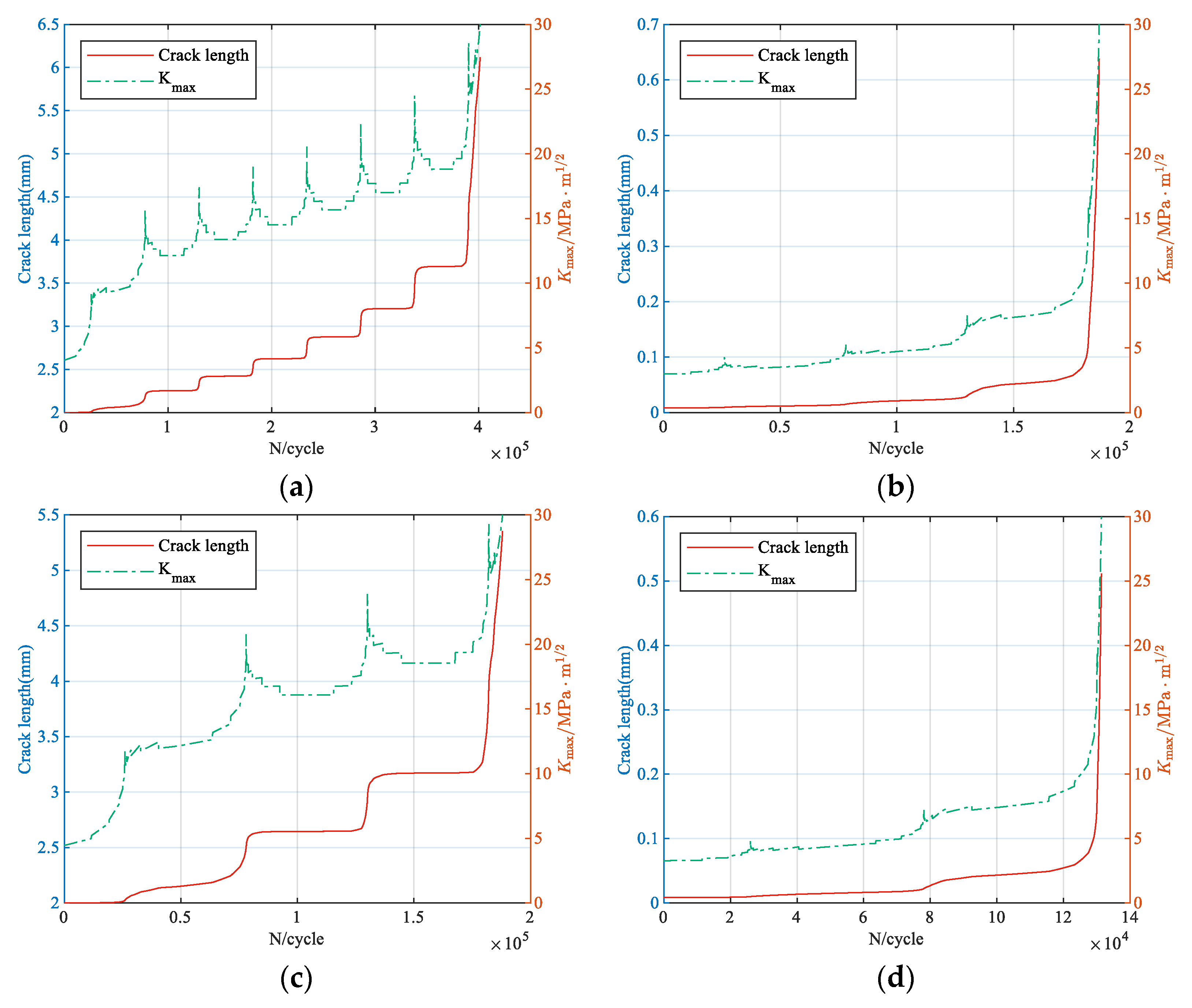
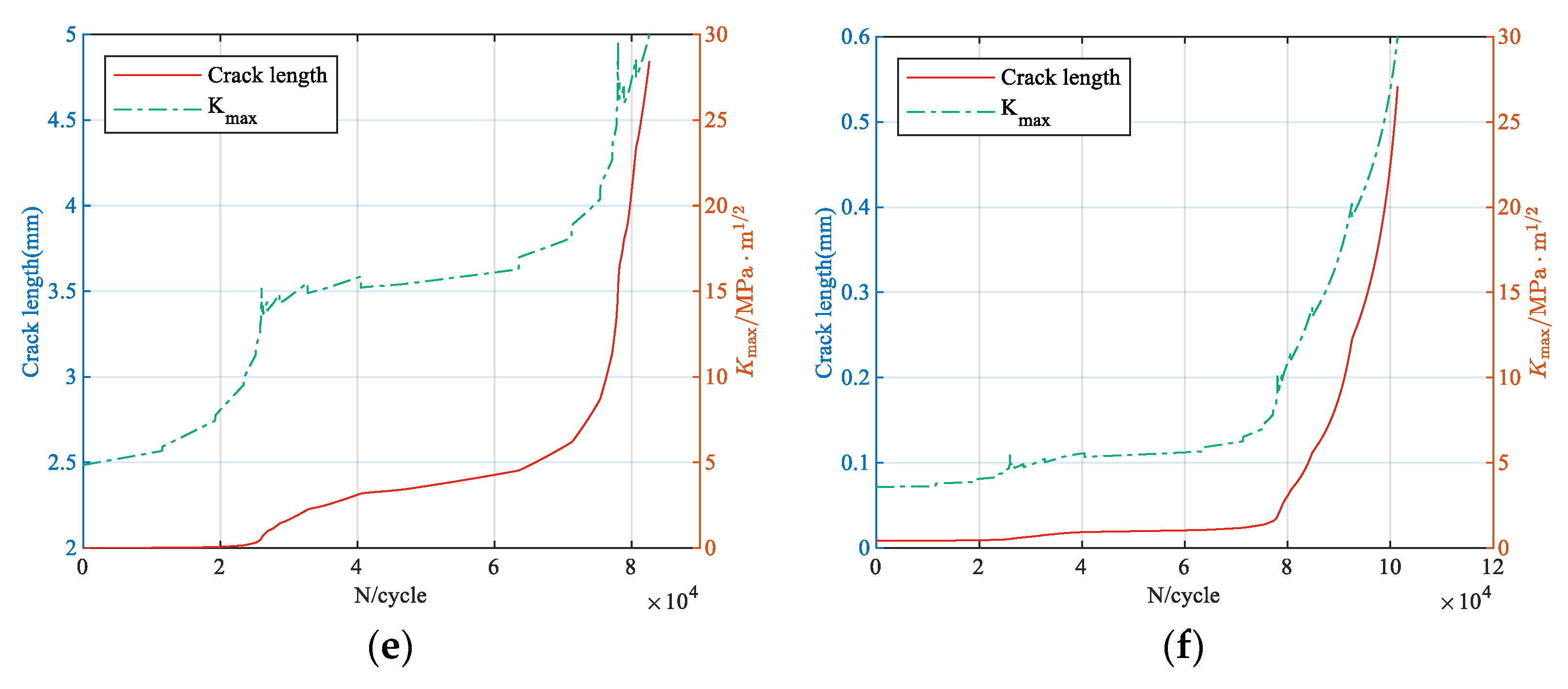
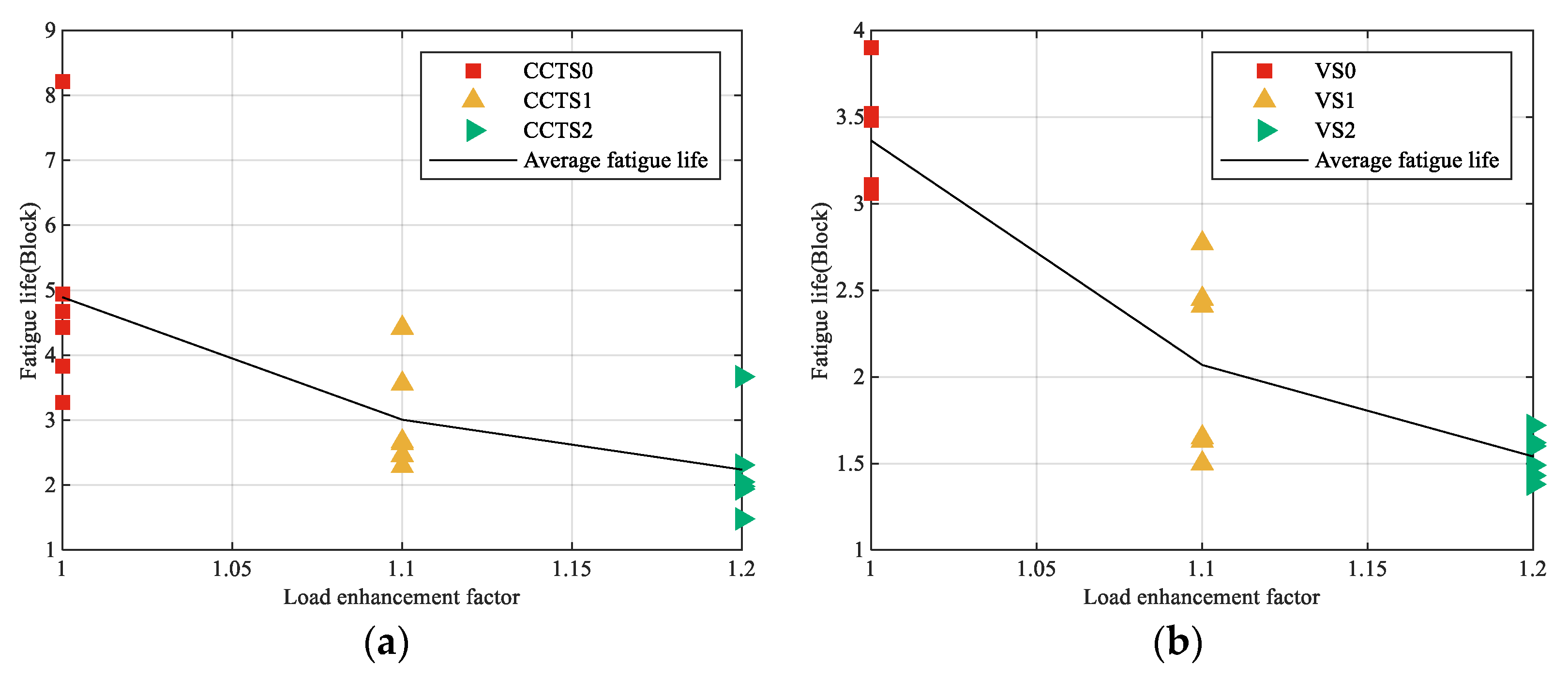

| Element | Si | Fe | Cu | Mn | Mg | Zn | Ti | Al |
|---|---|---|---|---|---|---|---|---|
| Min | 0.60 | 0.00 | 3.90 | 0.40 | 0.40 | 0.0 | 0.00 | Bal. |
| Max | 1.20 | 0.30 | 4.80 | 1.00 | 0.80 | 0.3 | 0.15 | Bal. |
| Material | lgC | m | R2 | RMSE |
|---|---|---|---|---|
| 2A14–T6 | −10.05 | 3.92 | 0.9977 | 0.0211 |
| Specimen | Kt | ΔKth,eff/MPa∙m1/2 | Δσfl/Mpa | aEIFS/μm |
|---|---|---|---|---|
| Central hole | 3.15 | 1.03 | 55 | 2040 |
| V-notched | 5.34 | 1.03 | 48 | 38.7 |
| Load Spectrum | Cycle (One Block) | Fatigue Life/Block | Fatigue Life/Cycles | Compression Ratio | |
|---|---|---|---|---|---|
| Central-hole | CCTS0 | 52,018 | 7.71 | 401,318 | 0 |
| CCTS1 | 3.61 | 188,011 | 53.2 | ||
| CCTS2 | 1.59 | 82,608 | 79.4 | ||
| V-notched | VS0 | 52,026 | 3.59 | 186,718 | 0 |
| VS1 | 2.53 | 131,367 | 29.5 | ||
| VS2 | 1.95 | 101,403 | 45.7 |
| Load Spectrum | Cycles | Fatigue Life/Block | Fatigue Life/Cycles | |
|---|---|---|---|---|
| Central-hole | CCTS0 | 52,018 | 3.27 4.67 4.94 3.83 8.21 4.43 | 170,540 242,924 256,969 199,229 427,067 230,440 |
| CCTS1 | 2.67 2.46 2.64 2.29 4.42 3.56 | 138,889 127,964 137,328 119,121 229,920 184,945 | ||
| CCTS2 | 2.05 1.98 3.67 1.48 1.94 2.31 | 106,637 102,996 190,906 76,987 100,915 120,162 | ||
| V-notched | VS0 | 52,026 | 3.52 3.11 3.06 3.11 3.48 3.90 | 183,131 161,801 159,200 161,801 181,051 202,901 |
| VS1 | 2.77 1.63 1.65 1.50 2.45 2.41 | 144,112 84,802 85,843 78,039 127,464 125,383 | ||
| VS2 | 1.60 1.38 1.62 1.43 1.72 1.49 | 83,242 71,796 84,282 74,397 89,485 77,519 |
| Specimen | Load Spectrum | Cycles | Mean Life /Block | Fatigue Life /Cycles | Compression Ratio/% |
|---|---|---|---|---|---|
| Central-hole | CCTS0 | 52,018 | 4.89 | 254,368 | 0 |
| CCTS1 | 3.00 | 156,054 | 38.7 | ||
| CCTS2 | 2.24 | 116,520 | 54 | ||
| V-notched | VS0 | 52,026 | 3.36 | 174,807 | 0 |
| VS1 | 2.07 | 107,694 | 37.27 | ||
| VS2 | 1.54 | 82,013 | 52.23 |
| Specimen | Load Spectrum | Experimental Value/% | Predicted Value/% | Error/% |
|---|---|---|---|---|
| Central-hole | CCTS0 | 0 | 0 | 0 |
| CCTS1 | 38.7 | 53.2 | 52.2 | |
| CCTS2 | 54 | 79.4 | 47.0 | |
| V-notched | VS0 | 0 | 0 | 0 |
| VS1 | 37.27 | 29.5 | −20.8 | |
| VS2 | 52.23 | 45.7 | −12.5 |
Disclaimer/Publisher’s Note: The statements, opinions and data contained in all publications are solely those of the individual author(s) and contributor(s) and not of MDPI and/or the editor(s). MDPI and/or the editor(s) disclaim responsibility for any injury to people or property resulting from any ideas, methods, instructions or products referred to in the content. |
© 2025 by the authors. Licensee MDPI, Basel, Switzerland. This article is an open access article distributed under the terms and conditions of the Creative Commons Attribution (CC BY) license (https://creativecommons.org/licenses/by/4.0/).
Share and Cite
Chai, L.; Wang, P.; Wang, Y.; He, Y.; Zhang, W. Investigation of Fatigue Load Spectrum Enhancement via Equivalent Plastic Zone. Materials 2025, 18, 5026. https://doi.org/10.3390/ma18215026
Chai L, Wang P, Wang Y, He Y, Zhang W. Investigation of Fatigue Load Spectrum Enhancement via Equivalent Plastic Zone. Materials. 2025; 18(21):5026. https://doi.org/10.3390/ma18215026
Chicago/Turabian StyleChai, Lindong, Penghui Wang, Yifu Wang, Yihai He, and Wei Zhang. 2025. "Investigation of Fatigue Load Spectrum Enhancement via Equivalent Plastic Zone" Materials 18, no. 21: 5026. https://doi.org/10.3390/ma18215026
APA StyleChai, L., Wang, P., Wang, Y., He, Y., & Zhang, W. (2025). Investigation of Fatigue Load Spectrum Enhancement via Equivalent Plastic Zone. Materials, 18(21), 5026. https://doi.org/10.3390/ma18215026






